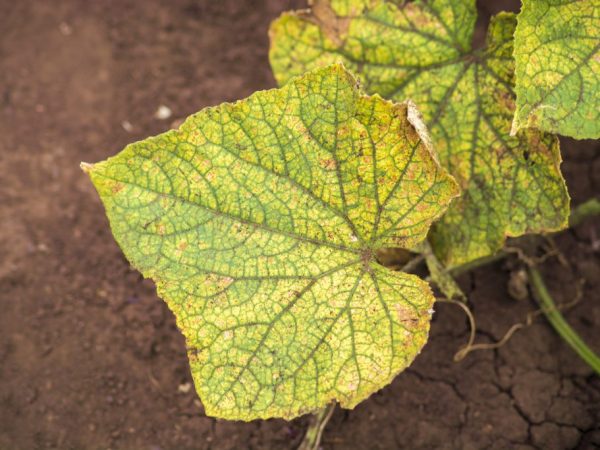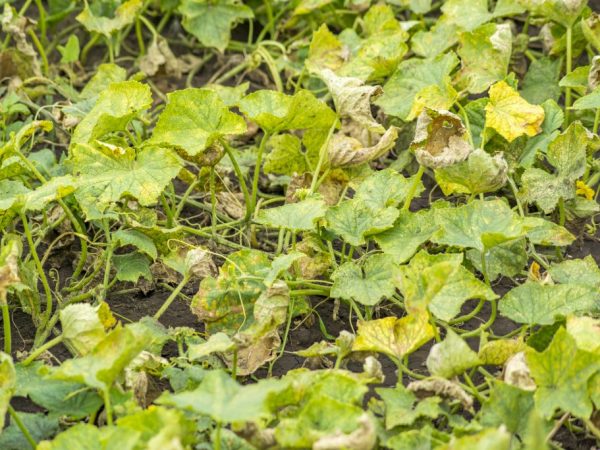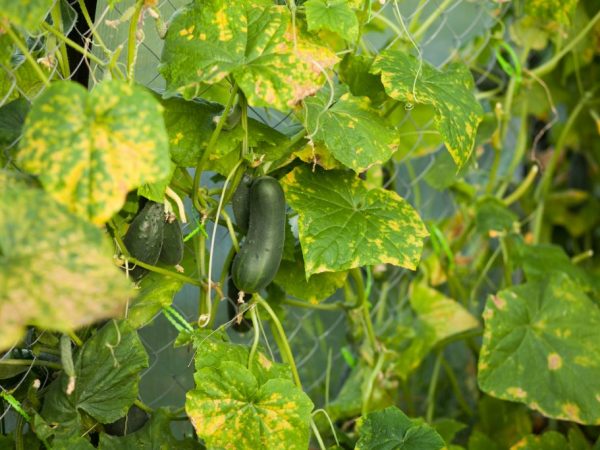Peronosporosis of cucumbers and methods of dealing with it
Cucumber downy mildew, or downy mildew, is a dangerous disease that can destroy all plantings and spreads very quickly. The disease is caused by a mushroom-like organism that parasitizes exclusively on pumpkin crops. It is difficult to treat it, in most cases the affected plants die. The main methods of prevention are seed treatment before planting, moisture regulation and compliance with agricultural practices.

Peronosporosis of cucumbers and methods of dealing with it
Description of the disease
The causative agent of peronosporosis is a pseudo-fungus, or mycoid Pseudoperonospora cubensis Rostowz, from the genus Pseudoperonospora, class Oomycetes.
The microorganism is able to exist and develop only by parasitizing on the tissues and organs of the host. It affects only pumpkin plants: cucumbers, zucchini, watermelons, melons, pumpkin, squash. Leaves, less often ovaries and flowers, are attacked by a pseudo-fungus.
The fruiting bodies of the microorganism that form on cucumber leaves produce oospores in early autumn. They fall into the ground, where they are able to overwinter even in fairly severe frosts. In spring, when the temperature rises to 12-18 ° C, oospores turn into zoospores. They are small, single-celled organisms with two flagella that can float in water. That is why the disease most often develops with increased air and soil humidity, in a rainy summer.
Getting with a drop of water on the lower part of a cucumber leaf, the zoospore penetrates into the stomata (plant organs that play the role of gas exchange). Inside the leaves, the peronospore forms a mycelium. Mycelium hyphae grow in the intercellular space, and its lateral processes penetrate into the cells. The false mushroom literally sucks the cucumber, takes water and nutrients from the cells.
The overgrown mycelium comes out, it can be seen on the bottom of the leaf in the form of a fluffy bloom with black dots. This plaque contains millions of oospores.
The pathogen is carried by the wind, parasitic insects. During its development, new leaves are constantly amazed. If it rains a lot in summer, up to 15 generations of a pseudo mushroom can develop on one plant.
Causes
For the development of downy mildew on cucumbers, a number of conditions are necessary:
- temperature difference (at night - about 13-18 ° С, during the day - 20-23 ° С);
- cold dew in the morning;
- high humidity;
- crowding of plants in the garden;
- watering with cold water.
Cucumbers are often attacked in poorly ventilated, cramped greenhouses. The weather is also important: in cold, rainy summers, downy mildew threatens pumpkin crops more than in hot and dry ones. The risk of disease is increased when aphids and other pests are parasitized on cucumbers.
Symptoms
Downy mildew does not appear on cucumbers immediately. The incubation period lasts approximately 3-10 days, depending on the air temperature. Optimal conditions for mycelium growth occur at 15-20 ° C.Most often, the defeat of cucumbers by the pathogen is observed in the second part of summer, when the nights become cold, precipitation falls more often.
The main symptoms of peronosporosis progress very quickly, cucumbers can die within 1-2 days. Here's how downy mildew manifests itself:
- yellow-green spots appear on top;
- below - gray bloom;
- under a magnifying glass, black spots are visible on a gray bloom, in which oospores ripen;
- spots increase in size, become gray-brown;
- the leaf is deformed and dries up;
- the flowers of plants turn black and fall off.
On an open bed in southern areas, the symptoms of downy mildew may be slightly different. The yellow spots are very small, the leaves themselves become rough, dark green.
As a result of the loss of foliage, photosynthesis is sharply reduced. Fruits lack nutrients. The cucumber itself is not affected, but it stops growing and loses its flavor. Together with the fallen leaves, the infection enters the soil and can stay there for 4-6 years.
Treatment of the disease

Treatment should be started as soon as possible.
If the first signs of the disease become noticeable, you need to immediately start treatment. The chances of saving the plants are slim, but worth the effort.
The affected leaves are removed first. Downy mildew on cucumbers spreads very quickly. It does not appear immediately, because the bushes must be checked regularly and new leaves with spots must be removed. After that, the culture is necessarily treated with fungicides. The most effective remedies are:
- Fitosporin-M;
- Gamair;
- Planriz;
- Alirin-B;
- Glyocladin;
- Efal;
- Acrobat MC;
- Kurzat;
- Radomil Gold;
- Planriz;
- Alirin;
- Strobe;
- Quadris;
- Topaz.
In the initial stages of the disease, you can also use traditional methods of combating plant fungi. For this, cucumbers are treated with the following means:
- soda (25 g) with soap (5 g), dissolved in 5 liters of hot water;
- copper sulfate (10 g), dissolved in 10 liters of water;
- sulfur solution (50-80 g / 10 l);
- Bordeaux liquid (100 g / 10 l of water);
- copper oxychloride 0.4%.
With these means, it is advisable to process the bushes twice, and then repeat the procedure a week later. It is also recommended to cultivate the soil. If downy mildew of a cucumber has affected most of the foliage, it is better to destroy the entire planting, the struggle for its survival in this case is practically useless. The tops are completely burned, the soil is dug up and disinfected. It is advised not to plant pumpkin crops at this place for another 3-4 years.
How to prevent peronosporosis
To prevent peronosporosis of cucumber, a number of actions are taken:
- correct agricultural technology;
- soil preparation;
- seed treatment before planting;
- care for cucumbers;
- treatment with antifungal agents for prophylaxis.
Let's take a closer look at the listed preventive measures against downy mildew.
Agrotechnics
When growing cucumbers, you should adhere to the crop rotation. It is undesirable to plant a crop in the same area for several years in a row after pumpkin, vegetable marrow, watermelon. The break between sowing these crops should be 3-4 years. It is best if onions, garlic, carrots were grown in the garden before the cucumbers.
If the cucumber does not grow in the open field, but in a greenhouse, it must be carefully processed after harvest and before planting seeds in the spring. It is important to provide the bushes with enough space and not to plant them too close to each other.
Soil preparation
In the fall, all tops should be removed from the site. If the plants have been infected, they must be burned. The earth is dug to a depth of 25-35 cm. You can treat the soil with 1% potassium permanganate, 2-3 copper sulfate or any fungicide preparation. This will not only kill the spores of the pseudo fungus, but also the causative agents of other cucumber diseases. The soil in greenhouses should be treated especially carefully.
Seed preparation
The causative agent of downy mildew can parasitize on seeds, although outwardly they practically do not change. To get rid of the false fungus, you need to take some measures before planting.You can place the seeds in hot water at 50 ° C for 15 minutes. You can also soak the seed in 1% potassium permanganate or Trichodermin solution for 2-3 hours.
Plant care

Regular airing will prevent plants from getting sick
So that adult plants do not get sick, they are planted as early as possible in the ground and covered with a film. It is important to control pests and weeds in the garden. Watering cucumbers should be moderate, you can not pour cold water under the bushes. If they grow in a greenhouse, the humidity should be maintained at 80%, the temperature should be in the range of 21-24 ° C, and the greenhouse should be regularly ventilated.
Preventive treatment of plants
To prevent infection, cucumbers should be treated with fungicides several times per season. They use the same drugs as for treatment, but at slightly lower concentrations. You can use some folk recipes:
- Take 10 drops of 5% iodine, add 1 liter of skim milk and 9 liters of water.
- 2 cups of ash pour 2-3 liters of boiling water, after 20-30 minutes filter through cheesecloth, add 10 liters of cold water.
- About 200-300 g of dry onion husks are poured into 10 liters of water and slowly brought to a boil, then insisted for 1-2 days.
- Take 1 part of cow dung and 3 parts of water, dilute, leave for 3-4 days, dilute with 7-8 liters of clean water.
You need to process cucumbers with these means for 2-3 days in a row, then repeat the treatment in a week. The advantage of folk methods is that they are environmentally friendly. Unfortunately, reviews say that such methods of struggle are not very effective. Ready-made drugs act on the pathogen much better.
Resistant varieties
Peronosporosis of cucumbers appeared in Russia in the 70-80s. He caused a decrease in yields, the death of entire plantations. Since it is rather difficult to fight the disease, varieties with high resistance to the pathogen have been developed over the past decades. The most stable and popular of them:
- Katyusha;
- Fontanelle;
- Photon;
- Octopus;
- Pasadena;
- Goosebump;
- Tom Thumb;
- Debut;
- Zodiac;
- Idol.
Hybrid varieties
Hybrid varieties of cucumbers are also highly resistant to the pathogen. Among them are:
- F1 alphabet;
- Buyan F1;
- F1 bouquet;
- Green wave F1;
- Emerald City F1;
- Ant F1;
- First class F1;
- Grasshopper F1;
- Focus F1;
- Farmer F1;
- Lord F1;
- Acorn F1;
- Compass F1.
Not a single variety or hybrid gives a 100% guarantee that it will not get sick with downy mildew, therefore, all the above recommendations should be adhered to, even when growing resistant varieties of cucumbers. Preventing a disease is much easier than curing it.


